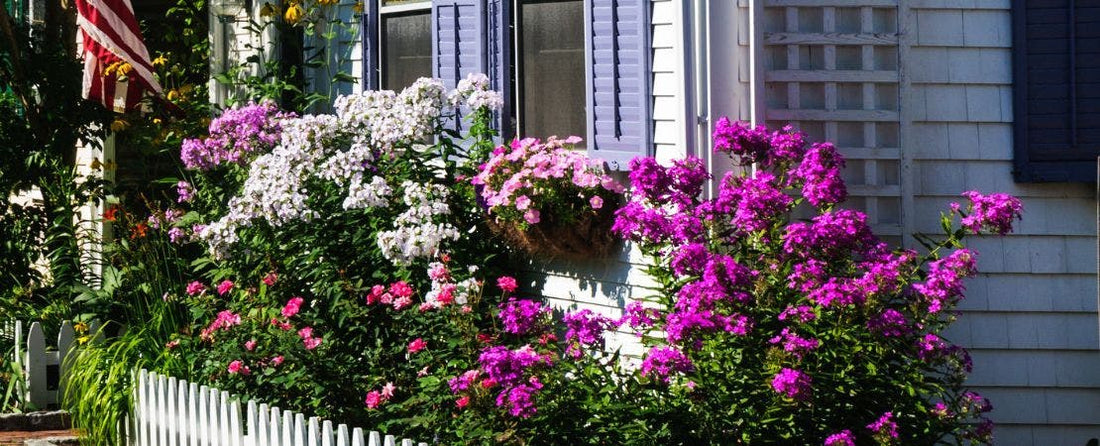Enjoy the Beauty of Phlox: A Perfect Addition to Any Garden

Phlox Flowers for Your Garden Spaces
Garden phlox are enchanting with vibrant colors and sweet scents. Let’s learn more about these timeless favorites. Generations of gardeners have enjoyed them, and you can too. Their variety makes them versatile with creeping phlox as ground cover and the paniculata type in borders, beds, and cutting gardens.
Why Grow Phlox?
- Colorful Blooms: Gentle pinks, bold purples, crisp whites, and fiery reds, phlox brings a burst of color to your garden. Each variety, from the delicate petals of Garden Girls® garden phlox to the creeping charm of Candy Stripe phlox, can fill your garden space uniquely and beautifully.
- Sweet Fragrance: The flowers emit a sweet, nostalgic scent you might remember from Grandma’s Garden. The fragrance appeals to butterflies, hummingbirds, and other pollinators. Place phlox near patios, walkways, or seating areas to enjoy the multi-sensory effects of beauty, fragrance, and nature.
- Versatile Planting: Phlox is a versatile addition to a sprawling backyard or a cozy balcony. They thrive in flower beds, borders, rock gardens, or containers, adapting to various environments. Phlox ability to flourish in both sun and partial shade makes them a perfect fit for almost any space.
Where to Plant Phlox?
Sunny Spots: Plant garden phlox (Phlox paniculata) and creeping phlox (Phlox subulata) in areas that receive ample sunlight. These sun-loving beauties thrive in full sun conditions and reward you by producing abundant blooms that brighten your garden view.
Shaded Nooks: Woodland Phlox (Phlox divaricata) finds its home in dappled shade, nestled among trees or along shaded pathways. Their delicate blooms add a touch of woodland charm.
Container Gardening: Gardening in a small space? Not a problem! Plant phlox in containers on your porch, balcony, or patio. Their compact size makes them ideal for adding splashes of color to small outdoor living spaces. Mix different phlox varieties in a single container for a vibrant and dynamic display. Creeping phlox for your spiller and garden phlox for your thriller.
TIP FOR PROFESSIONAL-LOOKING CONTAINER GARDENS!
Add Thrillers, Fillers, and Spillers: Pick one plant for the center of your pot, to be the star of the show (thriller); Surround your thriller with medium height flowers to fill in the space (fillers); Around the edge of your patio pot, add vining flowers or trailing plants that flow over the container’s sides (spillers).
Companion Plants for Phlox
Coral Bells (Heuchera): Pairing phlox with coral bells creates a striking contrast of colors and textures. The bold, ruffled leaves of coral bells complement the delicate blooms of phlox, resulting in a visually stunning combination.
Salvia (Salvia nemorosa): Create a pollinator paradise by planting salvia alongside your phlox. Bees, butterflies, and hummingbirds are drawn to the nectar-rich flowers of both plants, adding lively activity to your garden.
Daylilies (Hemerocallis): Daylilies and phlox make a dynamic duo, with their vibrant blooms creating a riot of colors. These hardy perennials thrive in similar conditions, providing continuous blooms throughout the season.
Why Grow Phlox?
Year-Round Beauty: Plant a variety of phlox types for blooms from spring to fall. Different varieties take center stage at various times, while the lush foliage adds texture and greenery to your garden even when not in bloom.
Low Maintenance Elegance: Phlox are hardy perennials that require minimal care. Once established, You can just sit back and enjoy their beauty without regular maintenance.
Wildlife Attraction: Invite beneficial insects and pollinators to your garden with phlox. Bees, butterflies, and hummingbirds are attracted by the nectar-rich blooms, aiding in pollination and adding life to your outdoor living space.
Phlox Myths and Misconceptions
Myth: Phlox is High-Maintenance
Reality: While phlox benefits from care, they're far from high-maintenance. Regular watering, occasional deadheading, and a light spring feeding are usually all they need to thrive.
Myth: Phlox is Prone to Disease
Reality: Proper planting in well-drained soil and good air circulation can prevent common issues like powdery mildew. Choosing disease-resistant varieties further reduces the risk.
Myth: Phlox Has Boring Foliage
Reality: Quite the opposite! Phlox offers a range of leaf colors, from deep greens to variegated patterns. Creeping phlox have spiky, dense leaves that can form a thick ground cover while garden and woodland phlox have graceful narrow leaves.
Phlox Leaf Diversity
Variety in Colors: Phlox plants surprise with their array of leaf colors, adding an extra dimension to your garden. From deep greens to silvery blues, variegated patterns, and even purples, phlox leaves are as diverse as their blooms.
Leaf Structures: While most phlox varieties feature lance-shaped leaves, there's subtle variation in size and arrangement. Some, like Woodland Phlox, have slender, elongated leaves for an airy look, while Creeping Phlox boasts dense, needle-like foliage forming a lush green carpet.
Embrace Phlox in Your Garden
Create a Colorful Display: Plant phlox in clusters for a breathtaking show of color. Mix and match different varieties to create a layered garden of blooms swaying in the breeze.
Savor Fragrant Moments: Surround a cozy corner of your garden with phlox to enjoy their sweet fragrance, inviting moments of peace and tranquility.


